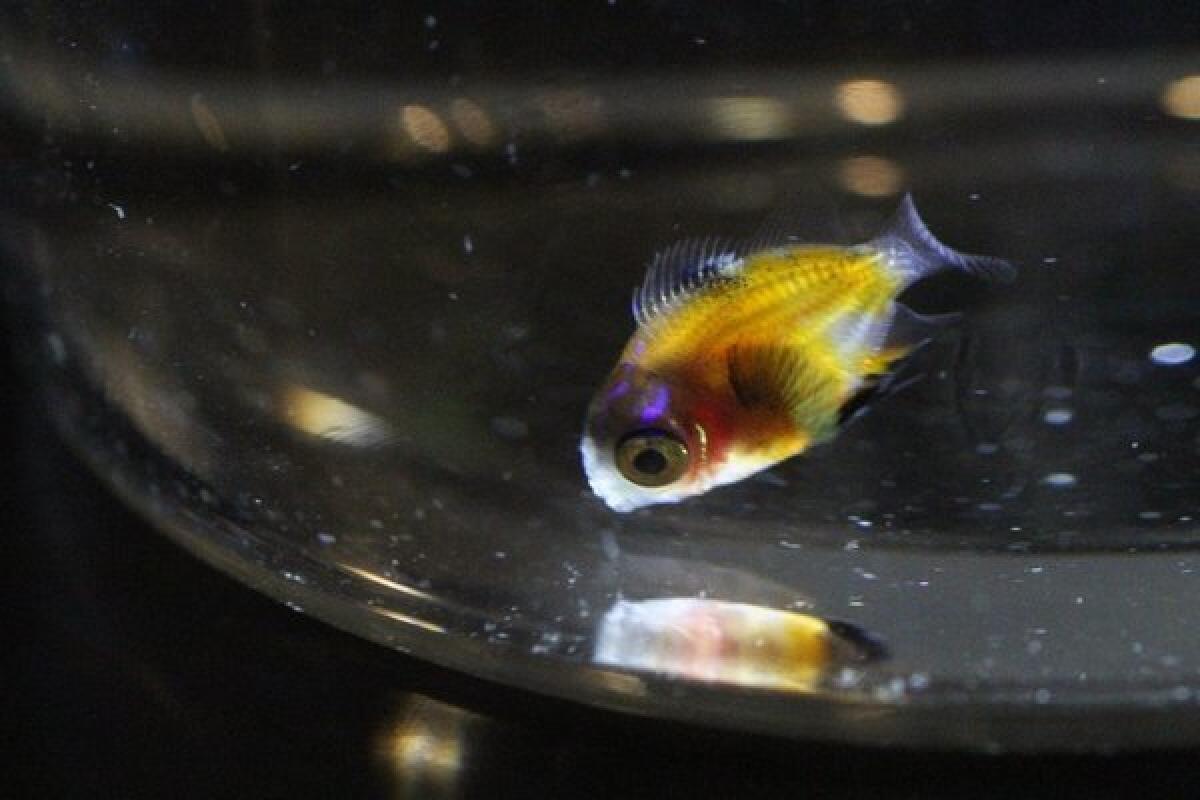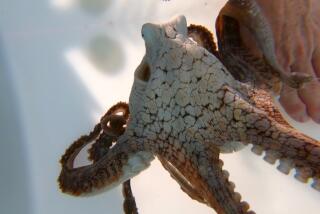Aquarium boosts reproduction of California’s state marine fish

- Share via
San Pedro’s Cabrillo Marine Aquarium has discovered a way to dramatically boost reproduction of California’s official state marine fish – the tangerine-colored garibaldi.
The aquarium is at the center of an unprecedented captive-garibaldi population explosion: 71 newborns, no bigger than pinkie fingernails, with electric-blue spots on their backs.
A year ago, most of those fish would have died in infancy.
But new care and feeding techniques have dramatically improved their survival rate.
“We were getting about seven to 10 garibaldi from the roughly 1,000 eggs we harvest each year at a nest on the breakwater,” said curator Kiersten Darrow, until staffers came up with the idea of adding microscopic creatures known as rotifers to their menus, and rearing the fish in much larger tanks.
Garibaldi, even as infants, are pugnacious, aggressively territorial creatures. With plenty of food morsels smaller than their gaping mouths and more space to stake out as turf, there have been fewer squabbles and injuries.
“Survival rates have soared,” said Mike Schaadt, director of the aquarium.
In the garibaldi’s natural environs, only two of the roughly 5 million eggs a female lays in her lifetime reach adulthood. “Life is tough for some organisms in the ocean – they starve or get eaten,” Schaadt said.
This year’s bumper crop turns out to be more than just a decade-long dream of swelling the ranks of baby garibaldi, which will eventually grow into bright orange adults the size of softballs. Schaadt says he plans to donate them to zoos and aquariums across the country as crowd-pleasing additions to conservation programs and research projects.
“I think we can raise up to 100 of these animals a year,” Schaadt said. “We’ll give them to our colleagues elsewhere at no cost.”
In Southern California coastal waters, the garibaldi population remains stable, a result of special state protections and incremental improvements in water quality, the legacy of state and federal laws curbing pollution, and the closure of marinas, shipyards and canneries that for decades spewed toxic chemicals, human waste and fish guts into the water.
That’s a positive trend for the entire offshore ecosystem, including leopard sharks and mussels.
Schaadt has made a lunch-hour ritual out of swimming to garibaldi nests he has discovered in submerged crevices on both sides of the breakwater. It takes him 15 minutes to reach nests he has been monitoring, and collecting eggs from, for about nine years.
Schaadt, who has a state permit to collect garibaldi eggs and raise the frie, uses a comb to tease out about 1,000 eggs and carefully deposit them in a plastic bag for transfer to the aquarium laboratory.
Sometime next week, the aquarium plans to put the word out: Garibaldi -- We got ‘em!
Marveling over a baby garibaldi hovering in a laboratory beaker, Darrow mused, “Our ultimate goal is to help others use this colorful animal’s charisma and behavior as an entre into Southern California’s coastal ecosystems, and our state’s natural identity.”
ALSO:
Temperatures expected to cool before heating up again
Third porn actor to test HIV-positive puts pressure on industry
SWAT team finds reportedly barricaded house in Boyle Heights empty
More to Read
Sign up for Essential California
The most important California stories and recommendations in your inbox every morning.
You may occasionally receive promotional content from the Los Angeles Times.











